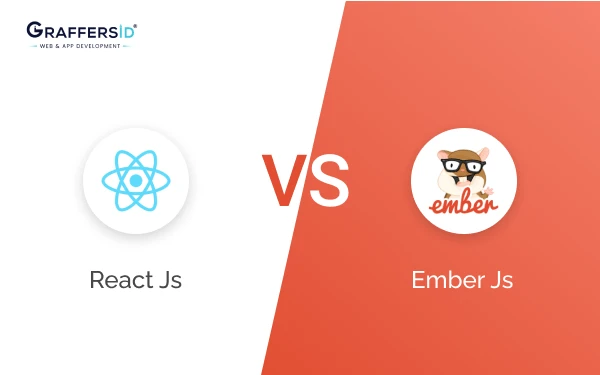When it comes to app development, we bet the first thing that comes to your mind is using JavaScript tools. Effectiveness and integrity, along with better functionality, are some of the parameters required to develop an outstanding app.
Regarding using JavaScript software, you have two choices: React JS and Ember JS. How are they different from one another, and what is right for your project? Read on to discover.
What Is React JS?
Like Ember JS, React JS is also a free, open-source JavaScript tool. React is a cost-effective, powerful library powered by JavaScript to help developers create interactive user interfaces for complicated website apps and websites that manage high traffic. To make coding easy, React has independent, reusable components and a custom syntax, JSX. Moreover, this framework uses multiple threads of codes to decide what should appear on the screen.
Uses Of React JS
React JS is usually used to create server-side rendered pages, SPA, interactive UIs, reusable components and real-time light-weighted experiences. In short, it is a perfect option for apps with regular updates. The framework also allows the developers to create presentable imagery for websites and mobile applications.
Here are some of the features of React JS:
- Component-based design with the help of Virtual DOM
- SEO friendly
- Reusable code components
- Fast rendering available
- Creation of isomorphic codes
- Less development time and coding efforts
- Simplified DOM manipulation
- Complete application customizability and flexibility
- Faster coding through XML-life syntax
Here are some of the companies that use React JS:
- Twitch
- OYO Rooms
- Netflix
- TED
- Heroku
- Square
- Runtastic
- Accenture
- Groupon
What Is Ember JS?
When it comes to React JS vs Ember JS, ember is a free, open-source framework used for creating highly functional web applications. The framework comes with a number of benefits, like a rich user interface and the ability to work from any device. The framework also allows developers to develop client-side JavaScript applications using several comprehensive tools. Moreover, the framework follows the MVVM model for UI architecture, thus allowing developers to build highly functional and interactive websites.
Simply put, Ember JS is accurately structured, stable, and a perfect platform that offers features like server-side rendering and two-way binding.
Uses Of Ember JS
To set things straight, Ember JS is perfect for long-term projects, web applications, single-page applications, etc. It also helps developers build websites with native features, apps that have an intense functionality platform, and apps that require a Python-like environment.
With Ember JS, you can get particular features like:
- Client-side rendering
- Ability to access data from multiple sources at the same time
- High-performance
- Skilled computer support
- Less prone to errors
- Proper documentation
- Totally fledged templating system
- Ember CLI that generates the right code-threads
- Enriched default architecture
Here are some of the companies that use Ember JS-
- Uber Eats
- Skype
- Netflix
- Airbnb
- The New York Times
- Bloomberg
- Discord
In an attempt to deliver ambitious and competitive web apps, you must choose the best frontend frameworks for web development. Looking at the rising need for responsive and scalable websites, JavaScript is considered the preferred programming language. Being one of the simple and relevant languages for app development today, JavaScript aids regular and progressive updates.
When it comes to app development, developers use quite a few frameworks to develop seamless solutions. And, the most widely-used JavaScript Tools are React JS and Ember JS. But, the trending discussion all over the internet is, which one is better than the other. Especially, those who are looking to Hire ReactJS developers in India are more concerned about the two tools.
Today, we are here with the core features, benefits, demerits, and a simple comparison between ReactJS and EmberJS.
If you have been looking for the best tool to use, read on to know about the different aspects of two tools so that you can pick the one that fits your needs and budget.
So, let’s begin without further ado.
React JS vs Ember JS Comparison For 2024
1. Performance
React JS –
React is an open-source library of JavaScript that offers a complete package of lean architecture and component-based workflow.
Thus, it is considered a lightweight platform that usually works for the presentation layer while complementing numerous elements of the app.
Also, when you have various elements, it allows reusing the components and rendering of JavaScript pages. All this contributes to its fast speed and great performance.
Ember JS –
Ember being a huge data library lags behind lightweight frameworks like React and works a bit slow. It allows for building large-scale applications with regular updates as change detection is slower.
Thus it affects the rendering, making it super slow for the first time. As there are innumerable components, Ember deals with the most complex functionalities and the performance metric is different from others.
2. Architecture
React JS-
You don’t get any default architecture in React JS and thus you have to search depending on the external libraries such as Redux and Flux. React with Flux architecture is commonly used in combination to develop web apps.
If you are looking forward to building seamless architecture React JS is a great option that you can use to develop client-side web apps. Developers can rely on the combination of React and Flux to develop a competent web app and provide users with an amazing user experience.
Ember JS-
When you work using the latest version of Ember, it comes with component-service architecture. However, the previous version of Ember followed the MVC pattern.
If you are looking forward to building applications with more native features, then Ember could be a better choice. Web apps with native features make them more unique, and the best part is that Ember supports the URL feature of the graphical user interface(GUI) framework as well.
We can say that Ember JS is capable of managing the application’s interaction with data. It can adjust to the rapid development process.
Also, it allows for numerous views, asynchronous programming, and using the advanced principles that modern web apps require.
3. Code Maintainability
React JS –
Another ground for the comparison is code maintainability where React JS can maintain the application code structure owing to its component-based architecture. All of this reduces the code complexity and time spent in developing apps.
While developing apps using React JS, you can emphasize UI aspects. Also, you can create custom hooks and reuse conditional logic time and again.
Moreover, you can isolate application components in a specific manner that supports the development of React JS applications. You can create easily testable components, and divide apps into specific parts for accessibility.
Ember JS-
If you are looking forward to following good coding practices, then Ember JS could be a great choice as it picks conventions over configuration. When you use Ember CLI and inbuilt tools for your app development it helps you keep the same layout of projects and follow the standard setups.
The Ember JS configuration maintains the code and helps reduce the code complexity. Thus, it ensures the proper organization of the code. All this contributes to achieving seamless debugging.
Moreover, it allows you to access anyone’s code that is easy to understand and doesn’t need a developer’s help.
4. User Experience
React JS –
React JS streamlines the UX by correctly aligning the development practices and design. Here, you will find several developer-oriented designs where the core community is steadily working to deliver a consistent user experience.
Dedicated React JS developers in India are required to stay cautious about bloating the web apps with unnecessary codes, which is called common abstraction. The best part is that the composition of components in React JS is defined in such a manner that minute changes don’t cause any trouble or disturb the complete codebase.
Thus, it ensures easy interoperability.
Ember JS –
As Ember JS is like a huge library of data and tools, you will get numerous tools here; so, you can use them all to design the web application as desired.
If you want to design a pre-testable user interface, you can create one by using Ember CLI and add-ons. They act as mock workers and APIs to test the user interface. When you use Ember CLI, you have the option of using exclusive features that are not provided by default.
Also, you can be used to add more reusable user interface elements.
Moreover, Ember JS comes with a product-based architecture that has proactive features, making it capable of delivering a better user experience in large applications.
Here is the Difference Between UI And UX Design
5. Use cases
React JS –
- React JS is used in creating single-page applications
- It offers interactive user interfaces
- The tool ensures the accuracy of the search engine
- If you are looking for a real-time lightweight application, React JS offers the best experiences
- If you are concerned about the design and presentation layer, you must consider React JS for mobile and web app development.
Ember JS –
- Ember JS is used for creating single-app applications
- If you are planning for long-term projects consider Ember JS as it is suitable for long-lived projects
- It provides a great platform for the seamless integration of complex functionalities
6. Community Support
React JS –
Being a popular JavaScript library React JS is loved by millions of developers worldwide. Owing to its simplicity, you will find great community support. React JS has more than 150 GitHub stars and questions.
Ember JS-
Ember JS comes with a robust foundation and stable community support. Thus, it is a popular library preferred by developers and tech giants.
It comes with more than 20k GitHub stars and Stack Overflow questions that have helped it secure its place as a platform of app development amongst developers.
Read Also: Benefits of Hiring Dedicated Developers
Advantages and Disadvantages of ReactJS and EmberJS
Advantages of React JS

- When it comes to React JS, the components can be easily imported without much dependency.
- You get a simple interface design along with easy-to-understand and learn API.
- The creation of universal web apps is possible due to server-side rendering.
- If you are considering JavaScript debugging, React JS is the best option.
- React JS allows for code reusability.
- You get great support from the React framework if you want to improve the performance of complex and troublesome components.
- The completely component-based architecture reduces code fragmentation.
Disadvantages of React JS
- You cannot call React JS a complete framework. Instead, it is a library.
- React JS has a steep learning curve that’s verbose and complex. Its documentation is difficult.
- A lot of configuration is required when you want to integrate React JS with the conventional MVC framework. A great example of this is Rails.
Read Also: What is Ar zone?
What Are The Advantages of Using React JS Over Ember JS?
Let’s delve into the advantages of using React JS over Ember JS, shedding light on why developers are increasingly gravitating towards this powerhouse framework.
Virtual DOM for Superior Performance:
React JS leverages a Virtual DOM (Document Object Model) to enhance performance. The Virtual DOM is a lightweight representation of the actual DOM, allowing React to efficiently update and render components. By minimizing DOM manipulation and only re-rendering components when necessary, React significantly boosts application speed and responsiveness. Ember, while proficient, lacks this specific optimization, making React a preferred choice for high-performance applications.
Component-Based Architecture:
React embraces a component-based architecture, enabling developers to break down complex user interfaces into modular, reusable components. This approach fosters code reusability, simplifies maintenance, and promotes scalability. Each React component encapsulates its logic and UI, fostering a clear separation of concerns. While Ember also supports components, React’s lightweight and flexible component model provide developers with greater control and agility in building sophisticated interfaces.
Unidirectional Data Flow with Flux/Redux:
React promotes a unidirectional data flow, which simplifies state management and enhances predictability. When coupled with libraries like Flux or Redux, React enables developers to maintain a single source of truth for application state, making it easier to debug and reason about data flow. Ember, on the other hand, follows a two-way data binding model by default, which can lead to unexpected side effects and complexity, particularly in larger applications.
JSX for Declarative UI:
React introduces JSX (JavaScript XML), a syntax extension that allows developers to write UI components in a declarative and intuitive manner. JSX seamlessly integrates HTML-like syntax within JavaScript, facilitating the creation of dynamic and interactive user interfaces. This approach enhances code readability, accelerates development cycles, and empowers developers to express UI components more naturally. While Ember supports similar templating capabilities, React’s JSX syntax offers a more cohesive and expressive development experience.
Rich Ecosystem and Community Support:
React boasts a vibrant ecosystem and extensive community support, providing developers with a wealth of resources, tools, and libraries to streamline development workflows. From state management solutions like Redux and MobX to testing frameworks like Jest and Enzyme, React offers a diverse ecosystem tailored to various development needs. The widespread adoption of React by tech giants such as Facebook, Instagram, and Airbnb further reinforces its credibility and ensures ongoing innovation and support.
Flexibility and Lightweight Core:
React prioritizes flexibility and maintains a lightweight core, allowing developers to integrate additional libraries and tools as needed without imposing unnecessary constraints. This flexibility empowers developers to adopt a modular approach, cherry-picking libraries and tools that best suit their project requirements. In contrast, Ember follows a more opinionated approach with a comprehensive set of conventions and tooling, which may be beneficial for certain projects but can also limit flexibility and customization options.
Strong Developer Tooling:
React offers robust developer tooling, including browser extensions like React Developer Tools and powerful CLI (Command-Line Interface) tools like Create React App. These tools streamline development tasks, facilitate debugging, and enhance productivity throughout the development lifecycle. With extensive support for hot reloading, time-travel debugging, and component inspection, React equips developers with the necessary tools to build and optimize modern web applications effectively.
While both React JS and Ember JS are formidable contenders in the world of front-end development, React’s distinctive advantages, including its Virtual DOM, component-based architecture, unidirectional data flow, JSX syntax, vibrant ecosystem, flexibility, and robust developer tooling, position it as a preferred choice for many developers and organizations. By harnessing React’s strengths, developers can unlock unparalleled efficiency, scalability, and performance, paving the way for the creation of exceptional user experiences in today’s dynamic web landscape.
Advantages of React JS for Large-Scale Applications:
- Scalability: React’s component-based architecture makes it highly scalable, enabling developers to efficiently manage and scale large applications by breaking them into smaller, reusable components.
- Performance: React’s virtual DOM and efficient rendering mechanisms optimize performance, ensuring smooth user experiences even in complex applications with vast amounts of data.
- Flexibility: React’s unopinionated nature allows developers to integrate it seamlessly with other libraries and frameworks, offering flexibility in technology stack choices for large-scale projects.
- Strong Community Support: React boasts a vast and active community, providing abundant resources, tutorials, and third-party libraries to aid developers in building and maintaining large-scale applications.
Advantages of Ember JS for Large-Scale Applications:
- Opinionated Structure: Ember’s opinionated structure provides a clear and consistent development path, making it ideal for large teams working on complex projects. Its conventions minimize the need for decision-making, leading to faster development cycles.
- Built-in Features: Ember comes with a robust set of features out of the box, including routing, data management, and testing tools, reducing the need to rely on third-party libraries and ensuring consistent standards across projects.
- Productivity: Ember’s focus on developer ergonomics and productivity-enhancing tools, such as Ember CLI and Ember Data, accelerates the development process, allowing teams to efficiently build and maintain large-scale applications.
- Stability: Ember prioritizes stability and long-term support, offering clear upgrade paths and backward compatibility guarantees, which are crucial considerations for large-scale applications requiring maintenance over extended periods.
When deciding between React JS and Ember JS for large-scale applications, several factors should be considered:
- Project Requirements: Evaluate the specific needs and constraints of your project, such as scalability, performance, and development speed.
- Team Expertise: Assess your team’s familiarity and proficiency with each framework, as well as their preferences and workflow compatibility.
- Long-Term Maintenance: Consider the long-term maintenance requirements of your application and the framework’s stability, community support, and upgrade paths.
Who Should Consider React JS?
For all those who are looking for speed and time efficiency, React JS could be a great choice. React JS is different from other languages due to the modular structure, and it helps simplify the entire process by pulling out pieces of the UI and then redoing it simply. Since React JS has a simple library, it reduces the challenges on part of web apps.
Advantages of Ember JS

- Ember JS comes with a strong data layer that seamlessly integrates with Java.
- It offers an object model that represents the underlying data and facilitates key-value observation.
- Ember JS supports the URL. Also, you get friendly docs and API.
- When it comes to using Ember JS, you will get to work with the best in-built practices. Here you get to use the wisdom of the software community and can benefit from others’ experiences.
- For long-term thinkers, Ember JS is the best framework to work upon as you get stability without any stagnation.
- Ember JS offers a fast boot time that helps in server-side rendering, which makes your app available to search engines, curl, and other scrappers.
Disadvantages of Ember JS
- While using Ember JS, you may come across piles of outdated content that may no longer work.
- You cannot reuse the components when you are working on the Ember Js framework.
- Ember JS is one of the most rigid and heaviest frameworks.
- It is not suitable for small projects.
Who Should Use Ember?
Ember JS is the best framework for ambitious developers who are willing to work on long-term projects. Today, you will see a great number of aspiring apps available in the market, and all those are mostly built using the Ember JS framework. As Ember JS comes with all tools, it is a great choice for those who want everything to work well.
Who Wins the Game Between Ember JS And React JS?
When it comes to determining the right framework for your app, it is best to understand your app needs and compare the merits of each framework.
However, you should have an in-depth knowledge of the merits and demerits of each framework. Thus, you should consider having the long-term support of tech agencies and active communities who can help you create web apps.
Well, many consider React JS as it has a super-fast approach to app development and it doesn’t even fall heavy on your pocket.
However, it depends on the agencies you have hired. Meanwhile, if you are looking to Hire React JS Developers in India, consider GraffersID. It has helped tech startups grow 5X by delivering exceptional value. You rely on their experience and expertise for your project.
Up for creating the best websites for engagement? Hire remote developers from third-world countries like India to pursue talent. We, at Graffers ID, are an IT staff augmentation company that allows you to outsource your needs and hire remote developers on a contractual basis.




